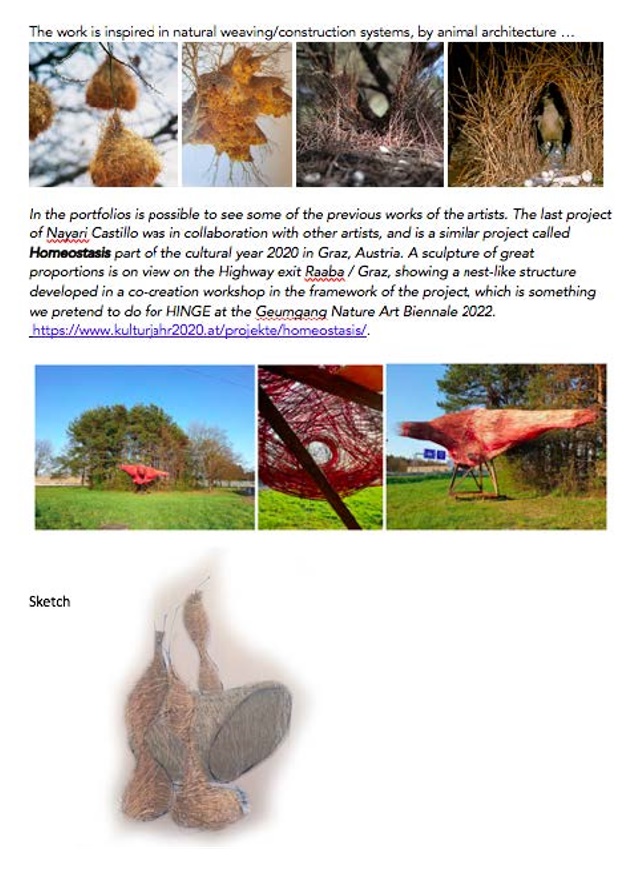[ 2021 ] 유디트 아우구스티노피크 (오스트리아), 나야리 카스티요-루트스 (베네수엘라) Judith Augustinovic (Austri…
페이지 정보
본문
유디트 아우구스티노피크 (오스트리아), 나야리 카스티요-루트스 (베네수엘라)
Judith Augustinovic (Austria), Nayari Castillo-Rutz (Venezuela)
<힌지 2.0 – 종(種)간 돌봄을 위한 중재 - Intervention for Cross-Species Caring>

자연과 공공공간에서 (인간을 포함한) 동물과 식물의 공존 가능성, 그리고 동물이 만든 건축물 & 보금자리들에 영감을 받아, 우리는 여러 가지 형태와 크기의 고리버들 (wickerwork) 지방 수공예품을 조각품/설치 작품으로 제안한다. 자연 재료들 (구조: 목재, 진흙, 나뭇가지 등 — 짜는 도구: 대나무, 버들, 등, 갈대, 등 — 깔게: 흙, 섬유, 나뭇잎, 등)만 사용해서 만든 여러 형태의 둥지들은 새, 작은 설치류, 곤충, 파충류를 위한 보금자리가 된다. 이러한 다양한 앉아서 쉬고, 놀고, 모일 수 있는 바구니 풍경은 다양한 토양으로 채워질 것이다 – 씨앗과 미생물이 풍부해서 자연이 시너지 효과를 낼 수 있도록. 그래서 보이는 것과 보이지 않는 것을 위한 만남의 영역을 제공해 줄 것이다.
시간이 지나면, 풍경-구조물은 동식물에 의해 점령되어, 이곳의 기온, 빛, 그 외 여러 지방 기후적 특징들에 의해 녹색의 생명의 터전으로 바뀔 것이다.
그리고 장기적으로는 모든 재료가 썩어서 없어질 것이기 때문에, 그냥 두면 작품은 흙으로 되돌아갈 것이다.
자연적인 인공 구조물로서, 이 작품은 비-침입적이고, 공생적이고, 생기 있고, 반응적인 방법으로 환경과 일체가 될 것이다.
이런 개입은 여러 생명체가 상호작용하고 상호의존하면서 공존을 조장하는 공간에서 집단적 만남의 방법을 제공한다. 이러한 공생적 구조에서 우리는 상호연결성을 인정하는 예를 제공하여 지속 가능한 미래를 위한 예술적 표현을 위한 작업에 이것을 제시하고자 한다. 그래서 동족 및 유기체 상호연결성에 대한 이 실험은 “모든 생물은 가장 깊은 의미에서 모두가 친척이다. 그리고 (개별적인 한 종이 아니라) 하나의 집단으로서 다루는 것이 낫다. 친족은 집단적인 종류의 단어이다. 단어의 의미상으로, 기호학적으로, 유전학적으로, 모든 생물은 공통의 ‘살 (flesh)'을 공유하고 있다.” (Haraway, 2016, p. 103).
인간을 포함한 모든 유기체는 구성적인 측면에서 서로 얽혀 있다 - 모든 생명은 다른 생명의 상호관계에 취약하다. 이런 콘셉트를 염두에 두고, 우리는 세계에 대한 통합적 비전을 장려하는 구조들을 설명한다. 복수성, 공존, 함께 하기, 종간 관계를 실험하는 것이 나의 제안 (proposal)의 주된 목적이다.
방법론 - 과정에 대한 설명. 우리는 공생, 상업주의와 같은 기존의 시너지들을 인정하면서, 어떤 작품이 개발되어, 씨앗, 토양, 식물과 조류의 종류, 작은 설치류, 곤충 등에 중요성을 부여하게 될 영역에 특유한 종들인지 이해하기 위하여 연구하고 싶다. 우리는 그 장소에서 발견되고 그 장소에 가지고 올, 미학적이면서 동시에 기능적인, 특별한 구조들을 개발할 것이다. 이러한 보금자리 경치 (nesting landscape) 단위들은 여러 종류의 바구니나 그런 도구를 짜는 기술을 가지고 개발될 것이다. Judith Agustinovic의 가구디자인과 건축적 발전에서의 기술들과 Nayarí Castillo의 설치작품 예술가이자 생물학자의 능력을 결합해서, 우리는 환경과 소통하는 서로 양육하고, 돌보는 풍경을 창조할 것이다.
Influenced by nature and the possibilities of coexistence of fauna(including human beings)&flora in public spaces, as well as inspired by animal-made architecture&shelters we propose a growing sculpture/installation of different volumes & forms made as wickerwork a (regional) handcraft. The composition of different sized nests, created by using only natural materials(structural: wood, mud, branches, etc; weaved: bamboo, willow, rattan, reed, etc&bedding:earth, fibers, leaves, etc) hosts alcoves for nesting for birds, small rodents, insects, reptiles. This created basket-landscape of different sitting, resting, playing, gathering possibilities will be filled with different kinds of soils – fertile in virtue of seedsµ- organisms, allowing nature to take its road and producing extra synergetic forms-offering a realm of encounters for the visible and the invisible.
With time, the sculptural landscape-structure will be taken over by flora&fauna, turning green and vivid, and responding to the immediate environment, to its temperature, light & other site-specific characteristics.
And in the long run, since all materials are biodegradable, when allowed, the piece will turn into soil again.
As a natural artificial structure, it will blend with the environment, in a non-invasive, co-existing, vivid and responsive way.
This Posthuman intervention offers a way to experience collective encounters in a multiplicities space, open to intra-action and interdependence with other beings, fostering coexistence with other species. With this symbiotic structure we seek to create an example recognizing the interconnectedness, putting it to work for artistic expression for a sustainable future, and active participation(among the visitors) in the appropriation of space. This experiment in thus about kin and organisms interconnectness: “...all earthlings are kin in the deepest sense, and it is past time to practice better care of kinds-as-assemblage (not species one at a time). Kin is an assembling sort of word. All critters share a common ‘flesh,’ literally, semiotically, and genealogically.” (Haraway, 2016, p. 103).
All organisms, including humans, are entangled with others in a constitutive way-all relational beings that are not invulnerable to others' interrelations. Taking this concept into account, we elaborate structures that foster a world's integrative vision. Experimenting with multiplicity and coexistence, togetherness and cross-speciesness is the main aim of this proposal.
Methodology-Description of the process We aspire to undergo a period of research to understand which are the species endemic to the zone where the piece will be developed, giving importance to seeds, soils, types of plants and birds, small rodents, insects, etc, as well as acknowledging pre-existing synergies as simbiosis, commensalism, among others present on the spot. We will develop specific structures combining natural materials found and brought to the spot, forms that are as well aesthetic and functional. These nesting landscape units will be created in connection and with different weaving and wickering techniques. Combining the skills in mobiliary design and architectural development of Judith Agustinovic, and the capacities as site-specific installation artist and biologist of Nayarí Castillo, we will create a nurturing and caring landscape that communicates with the environment.
- 이전글테네울 티에리 (프랑스) Teneul Thierry (France) 21.08.30
- 다음글알렉세이 세비아킨, 아나스타시아 안티포바 (러시아) Alexey Sebyakin, Anastasia Antipova (Russia) 21.08.30
댓글목록
등록된 댓글이 없습니다.


